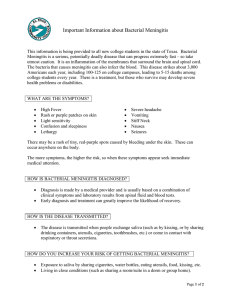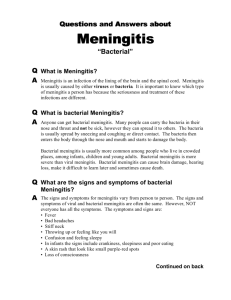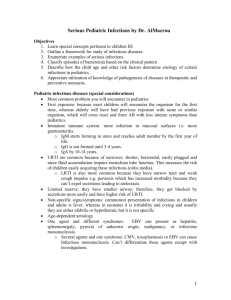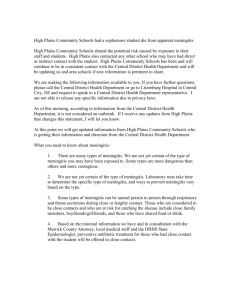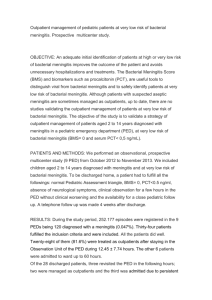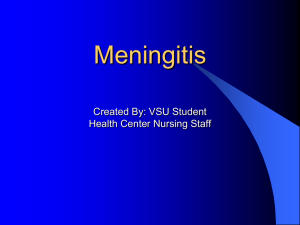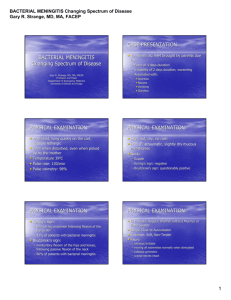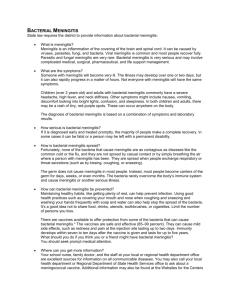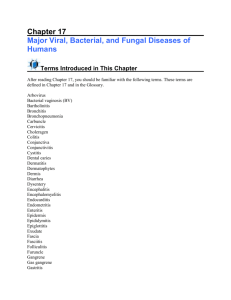Case Answers
advertisement
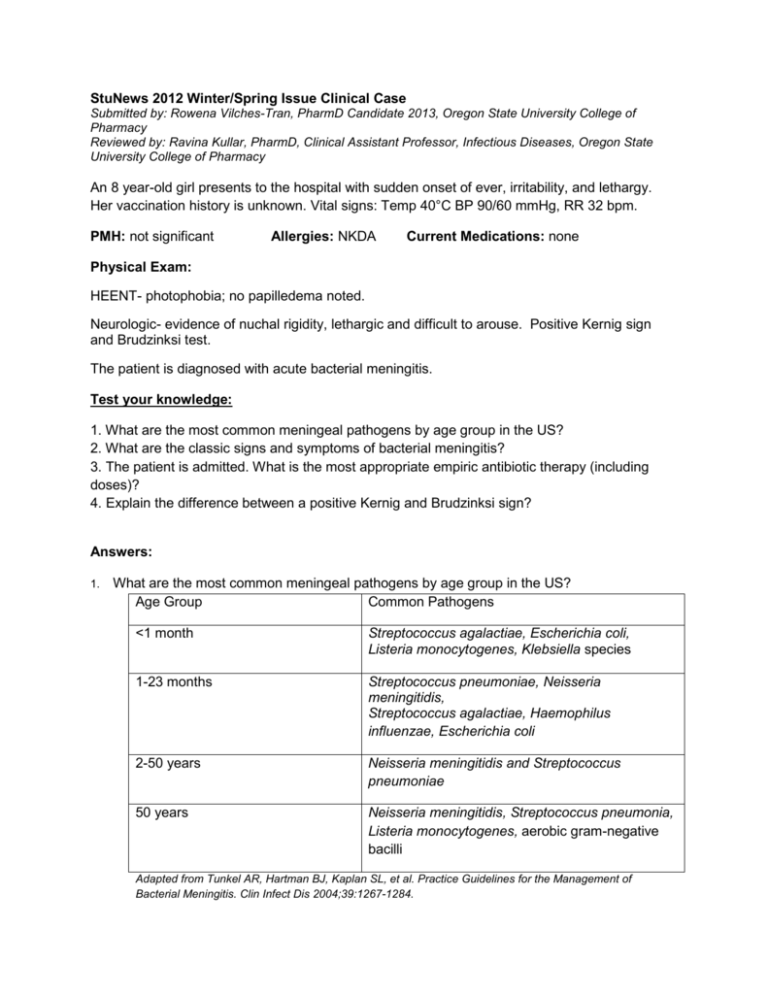
StuNews 2012 Winter/Spring Issue Clinical Case Submitted by: Rowena Vilches-Tran, PharmD Candidate 2013, Oregon State University College of Pharmacy Reviewed by: Ravina Kullar, PharmD, Clinical Assistant Professor, Infectious Diseases, Oregon State University College of Pharmacy An 8 year-old girl presents to the hospital with sudden onset of ever, irritability, and lethargy. Her vaccination history is unknown. Vital signs: Temp 40°C BP 90/60 mmHg, RR 32 bpm. PMH: not significant Allergies: NKDA Current Medications: none Physical Exam: HEENT- photophobia; no papilledema noted. Neurologic- evidence of nuchal rigidity, lethargic and difficult to arouse. Positive Kernig sign and Brudzinksi test. The patient is diagnosed with acute bacterial meningitis. Test your knowledge: 1. What are the most common meningeal pathogens by age group in the US? 2. What are the classic signs and symptoms of bacterial meningitis? 3. The patient is admitted. What is the most appropriate empiric antibiotic therapy (including doses)? 4. Explain the difference between a positive Kernig and Brudzinksi sign? Answers: 1. What are the most common meningeal pathogens by age group in the US? Age Group Common Pathogens <1 month Streptococcus agalactiae, Escherichia coli, Listeria monocytogenes, Klebsiella species 1-23 months Streptococcus pneumoniae, Neisseria meningitidis, Streptococcus agalactiae, Haemophilus influenzae, Escherichia coli 2-50 years Neisseria meningitidis and Streptococcus pneumoniae 50 years Neisseria meningitidis, Streptococcus pneumonia, Listeria monocytogenes, aerobic gram-negative bacilli Adapted from Tunkel AR, Hartman BJ, Kaplan SL, et al. Practice Guidelines for the Management of Bacterial Meningitis. Clin Infect Dis 2004;39:1267-1284. 2. What are the classic signs and symptoms of bacterial meningitis? The triad symptoms common to bacterial meningitis are fever, nuchal rigidity and altered mental status. However patients with bacterial meningitis may present with any of the following: headache, fever, meningismus (which maybe accompanied by Kernig’s sign or Brudzinski’s sign or both), altered mental status, vomiting, seizures, focal neurological findings and papilledema. 3. The patient is admitted. What is the most appropriate empiric antibiotic therapy (including doses)? 1. Vancomycin plus a third generation cephalosporin (ceftriaxone or cefotaxime).1 a. Vancomycin: 60 mg/kg maintain troughs 15 – 20 µg/mL b. Third generation cephalosporin: ceftriaxone 80-100 mg/kg or cefotaxime 225-300 mg/kg c. The use of dexamethasone therapy in infants and children is controversial.1 • Despite inconsistency in outcome of published data, the guidelines by the Infectious Diseases Society of America recommend the use of adjunctive dexamethasone therapy in infants and children with H. influenzae type b meningitis (A-I). Dexamethasone should be initiated approximately 10-20 min prior to the first antimicrobial dose (or at least concurrently) at a dose of 0.15 mg/kg every 6 hours for 2-4 days. • Data in infants and children who have pneumococcal meningitis are insufficient, thus it is imperative that clinicians weigh the potential risks and benefits in this population prior to administering adjunctive dexamethasone therapy (C-II). • Infants and children who have received antimicrobial therapy should not receive adjunctive dexamethasone, as it is unlikely to improve outcomes (A-I). 4. Explain the difference between a positive Kernig and Brudzinksi sign? A positive Kernig’s sign is present when a severe stiffness of the hamstrings causes an inability to straighten the leg when hip is flexed at 90 degrees due to pain. A positive Brudinski’s sign is present when severe neck stiffness causes patient’s hip and knees to flex when the neck is flexed. References: 1. Tunkel AR, Hartman BJ, Kaplan SL, et al. Practice Guidelines for the Management of Bacterial Meningitis. Clin Infect Dis 2004;39:1267-84. 2. Centers for Disease Control and Prevention (CDC). Vaccine information statement. Meningococcal vaccines: what you need to know. http://www.cdc.gov/vaccines/pubs/vis/downloads/vis-mening.pdf. Accessed December 21, 2011. 3. Tunkel AR, Van De Beek D, Scheld WM. Acute Meningitis. In Mandell, Douglas, and Bennett's Principles and Practice of Infectious Diseases, 7th Edition Edited by Gerald L. Mandell, John E. Bennett, and Raphael Dolin Philadelphia, PA: Churchill Livingstone Elsevier, 2009. Chapter 84, pp 1189-1229. 4. Chaudhuri A, Martin PM, Kennedy PGE, et al. EFNS guideline on the management of community-acquired bacterial meningitis: report of an EFNS Task Force on acute bacterial meningitis in older children and adults. European Journal of Neurology 2008;15:649-59.
